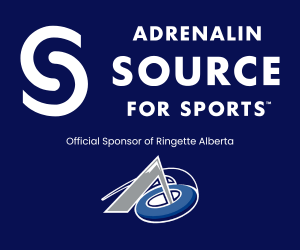Goaltender Development - U10 & U12
Ringette Alberta often gets asked, “How much playtime should a goaltender get at U10 & U12?”
Here are some notes we have put together on that topic:
- It is critical for people to understand that the stages in the LTAD model include broad chronological age ranges as a guide and that it is incorrect to say that U10, U12, etc. is absolutely equal to X stage.
- Coached and parents are encouraged to make informed choices about what is appropriate in an individual athlete’s journey.
- Using the LTAD model (as challenging as it is to read), the Ringette Essentials, the full Athlete Development Matrix once it is released will assist you in making the best decisions.
- Awareness of predictable attrition (in all sports, not just ringette) as players go through their teenage years tells us that putting all one’s eggs in a few (or one) goaltender basket at U10 and U12 will all but guarantee a goaltender shortage in U14, U16 and U19. We’re seeing that once again this September with everyone from C to AA asking Ringette Alberta to help them resolve goaltender issues exacerbated, in large part, by decisions being made in U10 and U12
- Folks often confuse “no early specialization” (in a particular sport) vs position specialization in ringette vs goaltender specialization vs the rest. It is okay to specialize in the goal years before it would be acceptable for players to specialise in forward, centre or defense.
- When an individual is not playing goal, this does not mean they must play another position. If they don't want to play forward, defense or centre, they don't have to.
- Kids that absolutely do not want to play goal shouldn’t be forced to, however, their refusal is often rooted in the fear of failure which is a manifestation of how much emphasis people put on the outcomes of games involving children. We’ve instituted the small nets to give kids who are trying goal a fighting chance. Other steps, like not keeping score will also help. Leagues and tournaments can take steps to make winning less of an emphasis.
- Generally speaking, at U10 Step 1 and U10 Step 2, all the kids should be rotated through all positions.
- Any individual may choose to be a full-time goaltender at any time, however a full-time goaltender is not necessarily entitled to play goal in every game.
- In Children’s Ringette, no individual may play goal more than:
- At Active Start and U10, 25% of the total games played by their team on or before December 31st and 25% after December 31st
- At U12, 75% of the total games played by their team on or before December 31st and 75% after December 31st.
- Above all, short term performance goals (winning now) needs to take a back seat to long term development objectives. What this means for goaltenders is not being too worried about winning at U10 and U12 so that teams are viable, because they have a goaltender, in subsequent years.
Please also note that “Full Time Goaltender” is not the same as a Goaltender who plays 100% of the time. A player who defines themselves as “Full Time” simply means that they do not play any other positions. With that said, if a team follows the 50% recommendation mentioned above, the “Full Time” Goaltender would sit out the game and not play when another player is in net.
Official Sponsors
Upcoming Events
Mar. 18, 2026 to Mar. 22, 2026
Western Canadian Ringette Championships
Saskatoon, Saskatchewan



